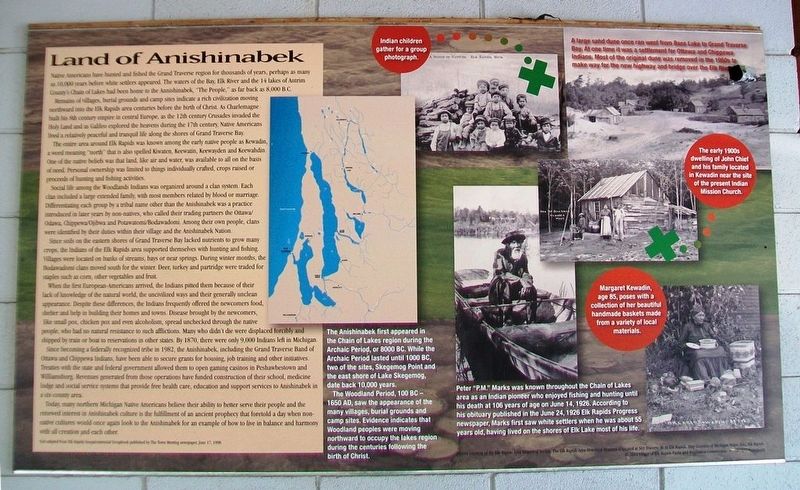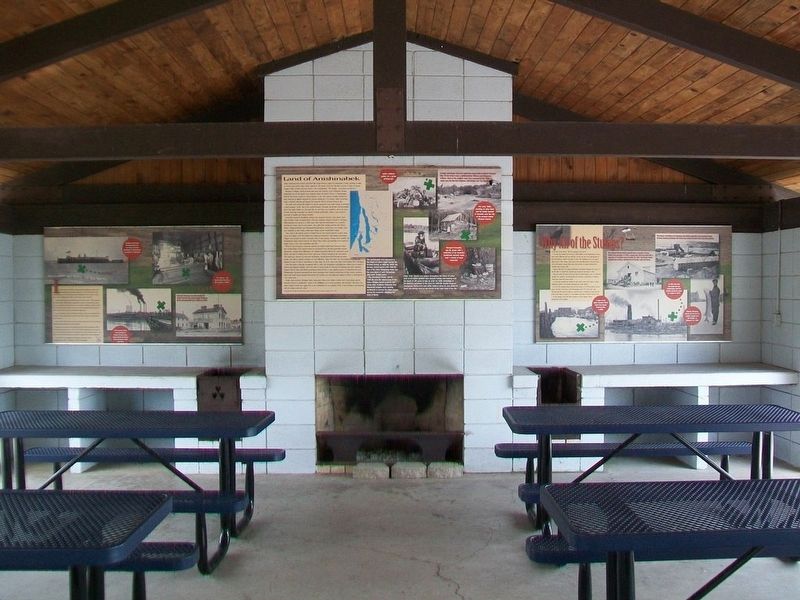Land of Anishinabek
Native Americans have hunted and fished the Grand Traverse region for thousands of years, perhaps as many as 10,000 years before white settlers appeared. The waters of the Bay, Elk River and the 14 lakes of Antrim County's Chain of Lakes had been home to the Annishinabek, "The People," as far back as 8,000 B.C.
Remains of villages, burial grounds and camp sites indicate a rich civilization moving northward into the Elk Rapids area centuries before the birth of Christ. As Charlemagne built his 8th century empire in central Europe, as the 12th century Crusades invaded the Holy Land and as Galileo explored the heavens during the 17th century, Native Americans lived a relatively peaceful and tranquil life along the shores of Grand Traverse Bay.
The entire area around Elk Rapids was known among the early native people as Kewadin, a word meaning "north" that is also spelled Kiwaten, Keewatin, Keewayden and Keewahdin. One of the native beliefs was that land, like air and water, was available to all on the basis of need. Personal ownership was limited to things individually crafted, crops raised or proceeds of hunting and fishing activities.
Social life among the Woodlands Indians was organized around a clan system. Each clan included a large extended family, with most members related by blood or marriage. Differentiating each
group by a tribal name other than the Anishinabek was a practice introduced in later years by non-natives, who called their trading partners the Ottawa/Odawa, Chippewa/Ojibwa and Potawatomi/Bodawadomi. Among their own people, clans were identified by their duties within their village and the Anishinabek Nation.Since soils on the eastern shores of Grand Traverse Bay lacked nutrients to grow many crops, the Indians of the Elk Rapids area supported themselves with hunting and fishing. Villages were located on banks of streams, bays or near springs. During winter months, the Bodawadomi clans moved south for the winter. Deer, turkey and partridge were traded for staples such as corn, other vegetables and fruit.
When the first European-Americans arrived, the Indians pitted [sic - pitied] them because of their lack of knowledge of the natural world, the[ir] uncivilized ways and their generally unclean appearance. Despite these differences, the Indians frequently offered the newcomers food, shelter and help in building their homes and towns. Disease brought by the newcomers, like small pox, chicken pox and even alcoholism, spread unchecked through the native people, who had no natural resistance to such afflictions. Many who didn't die were displaced forcibly and shipped by train or boat to reservations in other states. By 1870, there were only 9,000 Indians left in Michigan.
Since
becoming a federally recognized tribe in 1982, the Anishinabek, including the Grand Traverse Band of Ottawa and Chippewa Indians, have been able to secure grants for housing, job training and other initiatives. Treaties with the state and federal government[s] allowed them to open gaming casinos in Peshawbestown and Williamsburg. Revenues generated from those operations have funded construction of their school, medicine lodge and social service systems that provide free health care, education and support services to Anishinabek in a six-county area.Today, many northern Michigan Native Americans believe their ability to better serve their people and the renewed interest in Anishinabek culture is the fulfillment of an ancient prophecy that foretold a day when non-native cultures would once again look to the Anishinabek for an example of how to live in balance and harmony with all creation and each other.
Text adapted from Elk Rapids Sesquicentennial Scrapbook published by The Town Meeting newspaper, June 17, 1998.
The Anishinabek first appeared in the Chain of Lakes region during the Archaic Period, or 8000 BC. While the Archaic Period lasted until 1000 BC, two of the sites, Skegemog Point and the east shore of Lake Skegemog, date back 10,000 years.
The Wooldand Period, 100 BC-1650 AD, saw the appearance of the many villages, burial grounds and camp
sites. Evidence indicates that Woodland peoples were moving northward to occupy the lakes region during the centuries following the birth of Christ.
[Photo captions read]
• Peter "P.M." Marks was known throughout the Chain of Lakes area as an Indian pioneer who enjoyed fishing and hunting until his death at 106 years of age on June 14, 1926. According to his obituary published in the June 24, 1926 Elk Rapids Progress newspaper, Marks first saw white settlers when he was about 55 years old, having lived on the shores of Elk Lake most of his life.
• Indian children gather for a group photograph.
• A large sand dune once ran west from Bass Lake to Grand Traverse Bay. At one time it was a settlement for Ottawa and Chippewa Indians. Most of the original dune was removed in the 1950s to make way for the new highway and bridge over the Elk River.
• The early 1900s dwelling of John Chief and his family located in Kewadin near the site of the present Indian Mission Church.
• Margaret Kewadin, age 85, poses with a collection of her beautiful handmade baskets made from a variety of local materials.
Photos courtesy of the Elk Rapids Area Historical Society. The Elk Rapids Area Historical Museum is located at 301 Traverse St. in Elk Rapids. Map Courtesy of Michigan Maps, Inc., Elk Rapids.
©2012 Village of Elk Rapids Parks and Recreation Commission.
Erected 2012 by Village of Elk Rapids Parks and Recreation Commission.
Topics. This historical marker is listed in these topic lists: Environment • Native Americans • Settlements & Settlers. A significant historical year for this entry is 1870.
Location. 44° 53.807′ N, 85° 24.563′ W. Marker is in Elk Rapids, Michigan, in Antrim County. Marker is inside the Rotary Park Pavilion, on the right while traveling north on U.S. 31. Touch for map. Marker is at or near this postal address: Rotary Park, 305 US 31, Elk Rapids MI 49629, United States of America. Touch for directions.
Other nearby markers. At least 8 other markers are within walking distance of this marker. Elk Rapids (here, next to this marker); Why All of the Stumps? (here, next to this marker); Elk River, Entry to the Chain of Lakes of Antrim County (here, next to this marker); Because of the Water... (here, next to this marker); Rotary Park "Centennial Project" (here, next to this marker); Early Elk Rapids and the Elk River (here, next to this marker); First Methodist Episcopal Church (approx. 0.3 miles away); The Island House (approx. 0.3 miles away). Touch for a list and map of all markers in Elk Rapids.
Also see . . .
1. Village of Elk Rapids, Michigan. City website homepage (Submitted on September 24, 2016, by William Fischer, Jr. of Scranton, Pennsylvania.)
2. History of the Saginaw Chippewa Indian Tribe of Michigan. Ziibiwing Center of Anishinabek Culture and Lifeways (Submitted on September 24, 2016, by William Fischer, Jr. of Scranton, Pennsylvania.)
3. Anishinabek Folklore References. Michigan State University website entry (Submitted on September 24, 2016, by William Fischer, Jr. of Scranton, Pennsylvania.)
4. Anishinabek Nation Union of Ontario Indians. Website homepage (Submitted on September 24, 2016, by William Fischer, Jr. of Scranton, Pennsylvania.)
Credits. This page was last revised on May 18, 2022. It was originally submitted on September 24, 2016, by William Fischer, Jr. of Scranton, Pennsylvania. This page has been viewed 806 times since then and 75 times this year. Photos: 1, 2. submitted on September 24, 2016, by William Fischer, Jr. of Scranton, Pennsylvania.

